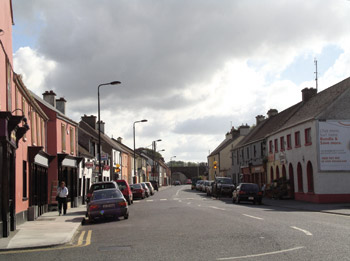Planning for the worst

The Competition Authority has asked that the grocery caps be lifted and the planning guidelines are already under review, so what’s on the horizon for the Irish retail landscape?
13 October 2008
In a report commissioned by RGDATA, leading planning consultants, MacCabe, Durney and Barnes, wrote that shopping centre footprint in Ireland has already “more than trebled in the last five years, from 400,000 sq m to 1,500,000 sq m.” In other words, “enough to create 118 new Croke Park pitches.”
However, when it comes to preventing large out-of-town developments, which potentially choke the vibrancy from town centres, planner Jerry MacCabe believes that Ireland has fared better than other European countries. “In Britain, the retailers themselves are the developers, who buy up sites and identify opportunities. In Ireland however, it has been more developer-driven, with developers then searching for retailing partners.
“Developers see opportunities, and work within the [planning] constraints, and then bring in their retailing partners to fit within that. So I think it’s actually easier for us here in Ireland, to direct retail development to the right sites than it is the UK where historically, the large retailers have soaked up big land banks over the last 15 to 20 years.”
The retailing caps in existence here, which limit a store’s grocery footprint to 3,500 sq m within the greater Dublin area and 3,000 sq m outside Dublin, are intended to safeguard the cultural and social role of town centres. However, the Competition Authority’s latest report recommended their removal, deeming that they have “deferred the most price aggressive grocery retailers from entering the market.”
Where to now?
Jerry remains unsure of what the outcome regarding revision to the planning guidelines will be, but notes that so far, “the retail caps have worked well…so I don’t think there’s any logic or reason to lift that cap.”
After all, we don’t want to go down the route of other countries that only realised what they had when it was too late. A potent example is France, land of the hypermarket.
“France now has highly regulated mechanisms to control retail development, after the horse has bolted. France has an intensely regulated planning regime now and any minor addition to retail provision has to go through a whole commission. This is the last thing we would want here but has happened as a result of past policies.
“There’s also a major movement now in Britain to try and reinvigorate town centres and market towns because they’ve been gutted by large out of town retail boxes. Wouldn’t we be in a better position to hold on to what we have and learn from the mistakes of others rather than opening up in a laissez-faire, free-for-all, only to say in 10 or 15 years how could we let this happen?”
Hearing from the retailers
We wanted to know what retailers in small Irish towns think, so we decided to find out first hand, by visiting the home town of arguably the most powerful man in Irish politics, An Taoiseach Brian Cowen.
Clara in County Offaly has a population of roughly 3,500 and is flanked by the larger town of Tullamore, whose retail landscape includes two Dunnes Stores, a Tesco, and two discounters, Lidl and Aldi. Some 10 minutes south of Tullamore, we also visited the small rural settlement of Killeigh, which is served by two independents; Langton’s Grocery and Gorman’s newsagents. Were these retailers concerned about the potential lifting of the retail caps?
In Gorman’s newsagents, which has a small deli and grocery offering, it was felt that the presence of discounters nearby would actually bring more trade into the shop. “Sundays used to be good…before the recession” the owner said. A direct result of traffic passing on the way to or from a nearby discount (non-grocery) retailer, brought increased footfall as “they’d stop here to get their sweets and newspapers.” So Gorman’s would appreciate another consumer draw in the vicinity to bring customers past its door.
In Langton’s Grocery, which was more convenience and deli-orientated, we heard a similar story. When asked if worried about greater competition from large supermarket chains, the staff member we spoke to replied: “They’re already here.” Never mind out-of-town, thanks to the roads, Blanchardstown shopping centre is potentially less than an hour’s drive away.
So ultimately these stores aren’t worried. People could easily do a grocery shop elsewhere, but are less willing to get in the car for a pint of milk or daily paper. Perhaps therefore, it’s the medium-sized supermarkets who have more to be concerned about?
The vulnerable ones
This is the message we heard in Clara. Baggot’s Centra is confident about its own “strong customer base” in the town. While Tullamore is “always the draw for a big shop”, this poses no great threat to the store’s convenience offering. In fact, it would be good to have development nearer to Clara than Tullamore to keep the customers closer, the c-store owner said.
In comparison, Knight’s Londis in Clara is a larger store with a floor space of between 4,500 and 5,000 sq ft, and manager Des Whearty feels, “there needs to be a cap put in place.” The shop retains its customer base by “concentrating on service, and focusing on local promotions.” However, Des does perceive a greater threat, particularly from multiples engaged in supermarket war, noting that Tesco.com vans are frequently “in and out of Clara.”
Talking to the establishment – planning and legislation is only part of the solution
If everyone is agreed that local shops provide a vital service to the community, and that they are in danger of disappearing in the face of unmatchable competition from supermarket giants, then surely there has to be some manifesto at government level to address this serious problem. A problem that is escalating and likely to have passed the point of resolution if not dealt with soon.
Everybody is also aware that competition is vital for the health and dynamism of any sector, and essential for ensuring that consumers have access to everything they need and also, that they get value for their money. It’s a graspable economic principle.
So what is the solution? More to the point, what do the elected representatives intend to do? And do they at least have any ideas? In a bid to find out, I first contacted the office of Minister for the Environment, Heritage and Local Government, John Gormley, to ascertain his views on the CA’s proposal.
In a response (see below) drafted on his behalf it said that Gormley noted that the CA report is based on the experience of the seven largest grocery retailers operating in Ireland, and that he was also considering it along side the RGDATA commissioned report, which is “broadly supportive of the existing guidelines while recommending strengthening in some regards”.
The letter then reiterated some of Gormley’s initial statement saying it was right and proper to be carrying out this current review of the guidelines but added: “Increased demand for retail outlets in existing and expanded towns and cities across the country, good planning and the need to reduce car dependency, and the need to ensure continued healthy competition in the retail sector are key considerations that will underpin the review. Not all of these factors will have been considered within the scope of the Competition Authority report.”
Gormley also believes that a new retail development should “be encouraged to contribute to the vitality and vibrancy of town and village centres, to ensure that they retain retailing as a core function.”
Market saturation
The response of John Gormley was no more than expected from a member of the Green Party, and we assume he will act accordingly. This however, does not address all of the issues facing the retail sector, in which many livelihoods remain at stake.
Head of Retail Studies at the University of Ulster, Donald McFetridge confirmed what has long been suspected about the Irish retail sector.
“I firmly believe that the Irish retail grocery market is close to, if it has not already reached, superstore saturation point. There is very little room left for expansion in this area of the marketplace.”
So what, we ask, can be done to help drive a maturing industry on the brink of market saturation towards a more sustainable future? We contacted the Department of Enterprise, Trade and Employment, and the office of the Tainaiste, Mary Coughlan, to hear what is in the Government’s manifesto for the development of this vital sector. Unfortunately, as we went to print we were still waiting for a response.
We did, however, receive replies (see below) from some of the 160 local TDs we emailed. The majority (26) of those who responded (30) reject the CA’s view, saying that they have no confidence in its effectiveness and that they would also favour greater transparency of large operators’ turnover figures. Three TDs said they are in favour of scrapping the planning guidelines; they were Margaret Conlon (FF), Cavan/Monaghan, Michael Moynihan (FF), Cork North West, and Olivia Mitchell (FG), Dublin South.
Gormley restates intention to review Retail Planning Guidelines
The full response as issued to ShelfLife magazine
The Minister for the Environment, Heritage and Local Government, Mr. John Gormley T.D. today (10 September) noted the publication of the report by the Competition Authority, The Retail Planning System as Applied to the Grocery Sector: 2001-2007. The report, which is based on the experience of the seven largest grocery retailers operating here from 2001 to 2007, recommends a number of changes to the Retail Planning Guidelines published by the Minister’s Department.
The report by the Competition Authority comes on top of a report published earlier this week for RGDATA by MacCabe Durney and Barnes Consulting, Planning Consultants, Sustainable Retail Development – an Evaluation of the Effectiveness of the Retail Planning Guidelines. This report recognises the role of the retail planning guidelines in supporting and promoting retail development in appropriate locations both within and around urban areas, and is broadly supportive of the existing guidelines while recommending strengthening in some regards. The report states that there has been a 275% increase in shopping centre floorspace in the last 6 years.
Last week, the Minister announced that he intended to initiate a review of the retail planning guidelines in 2009. The Retail Planning Guidelines for Planning Authorities have been in effect since 2001 and were further amended in 2005 to remove the floorspace cap on retail warehouses under certain circumstances.
The Minister said “It’s appropriate that we have these type of analyses to input into the review of the Retail Planning Guidelines. In proposing any adjustment to retail planning policy we need to take into account broader issues around the availability, location and accessibility of retail development, the need to support the continuing role of town and district centres in maintaining vibrant towns and villages while at the same time facilitating a competitive and healthy environment for the retail industry.”
Minister Gormley added, "Since the Guidelines came into force in 2001, Ireland has undergone considerable change in terms of economic and social development, particularly in relation to population expansion and settlement patterns. Increased demand for retail outlets in existing and expanded towns and cities across the country, good planning and the need to reduce car dependency, and the need to ensure continued healthy competition in the retail sector are key considerations that will underpin the review. Not all of these factors will have been considered within the scope of the Competition Authority report."
The principles to guide the review are that:
• competition to the benefit of the consumer should be maintained and enhanced
• existing retail development-type definitions and relevant floorspace limits will be assessed to determine whether they remain appropriate or whether they need to be amended
• preferred locations for retail development should continue to be guided by considerations of sustainable land use, including access by public transport
• in particular, new retail development should be encouraged to contribute to the vitality and vibrancy of town and village centres, to ensure that they retain retailing as a core function
• realistic, forward-looking strategies for plan-led retail development are devised and that planning authorities, developers and shop owners are given clear guidance in formulating development or expansion proposals.
The review will also take account of other key complementary planning and development policies including the National Spatial Strategy and Regional Planning Guidelines, along with more recently published planning guidelines on Development Plans (2007) and Development Management (2007) and the Sustainable Residential Development in Urban Areas (2008) and recent research into development in the retail sector, in particular the grocery sector.
The Competition Authority, planning authorities, retailers, developers, representative bodies and all interested parties and individuals will be consulted during the review.
TDs reject Competition Authority view on RPG’s and call for greater multiple profit transparency
The complete results of ShelfLife’s survey of local TDs
The majority of TDs who responded to a recent ShelfLife survey reject the Competition Authority’s view in relation to the Retail Planning Guidelines. In addition the majority of respondents said they have no confidence in the Competition Authority’s effectiveness and would also favour greater transparency of large operators turnover figures.
In total 30 TDs responded to our email survey. The majority of TDs (26) said that they did not agree with the total removal of the planning guidelines. One had no opinion, while three said they would favour the scrapping of the Planning Guidelines.
23 TDs said that they do not believe that the Competition Authority is effective as a Statutory Agency responsible for promoting and enforcing law. The Fine Gael party’s position is that it should be merged with the NCA (see below). Only six TDs felt that the Competition Authority was effective.
Asked if they believed that large operators in the market should be compelled to disclose their turnover figures, 26 TDs said that they should while four said that they should not have to.
The Questions
- Would you be in favour of the removal of the planning guidelines as recommended by the Competition Authority? (i.e. remove caps on grocery retail floor space)
- Do you believe that the Competition Authority is effective as statutory agency responsible for promoting and enforcing competition law?
- At present the largest operators in the retail grocery sector (Tesco/Dunnes/Superquinn/Lidl & Aldi) do not disclose their profit figures. Do you believe that they should be compelled to disclose details of their turnover and profitability so that consumers can make their own minds up about whether they are being ripped off or not?
Emmet Stagg (Lab, Kildare N) 1) No 2) No 3) Yes
Thomas Broughan (Lab, Dublin NE) 1) No 2) No 3) Yes
Paul Gogarty (Green, Dublin Mid West) 1) No 2) No 3) Yes
John Perry (FG, Sligo N/Leitrim) 1) No 2) No 3) Yes
Michael D Higgins (Lab, Galway W) 1) No 2) No 3) Yes
Arthur Morgan (SF, Louth) 1) No 2) No 3) Yes
Caoimhghin O Caolain (SF, Cavan/Monaghan) 1) No 2) No 3) Yes
Finian McGrath (Independent, Dublin NC) 1) No 2) No 3) Yes
Olivia Mitchell (FG, Dublin S) 1) Yes 2) No 3) No
Noel Treacy (FF, Galway E) 1) No 2) Yes 3) Yes
Margaret Conlon (FF, Cavan/Monaghan) 1) Yes 2) Yes 3) Yes
Seymour Crawford (FG, Cavan/Monaghan) 1) No 2) Yes 3) Yes
John Browne (FF, Wexford) 1) No 2) No 3) No
Michael Ring (FG, Mayo) 1) No 2) Yes 3) No
Padraic McCormack (FG, Galway, West) 1) No 2) No 3) Yes
Sean Connick (FF, Wexford) 1) No 2) No 3) Yes
Michael Moynihan (FF, Cork NW) 1) Yes 2) Yes 3) Yes
Terence Flanagan (FG, Dublin NE) 1) No 2) No 3) Yes
Michael Kennedy (FF, Dublin N) 1) No opinion 2) Yes 3) No
Darragh O’Brien (FF, Dublin N) 1) No 2) Inconsistent 3) Yes
Denis Naughten (FG, Rosscommon S/Leitrim 1) No 2) No 3) There must be transparency
*Mary Hanafin does not respond to surveys.
*James Bannon took exception to an email sent by ShelfLife and withdrew from the survey.
The Fine Gael Response
1
The Competition Authority has not recommended the removal of the retail planning guidelines. The Competition Authority has recommended six amendments to existing guidelines of varying significance. We would not favour the removal of the retail planning guidelines altogether.
Fine Gael strongly supports increased competition and a greater diversity of outlets in the retail sector. This will improve choice for consumers and keep prices competitive. Fine Gael also believes that government should support family-run businesses provided it is not done at the expense of consumers.
It is our strong preference that large new retail developments should be located in city and town centres rather than in retail parks on the outskirts of our towns and cities for environmental, social and planning reasons.
In our ‘Ending Rip-Off’ policy document which was published in 2007, we proposed:
Monitoring of the application by local authorities of the Retail Planning Guidelines to ensure consistent interpretation in a way that promotes retail competition
Identification of more suitable locations for large store formats, like IKEA, and amend the Retail Planning Guidelines accordingly
Empowering the Competition Authority to carry out a new study of the grocery sector to ensure that supermarkets are not engaging in practices, such as ‘land-banking’ and predatory pricing, that suppress local market competition
Increasing the numbers of casual trading licences granted to open air traders and apply a locally-sensitive approach to casual trading regulations across local authorities by means of statutory based guidelines, if necessary by amending the Casual Trading Act of 1995.
2
NO. Fine Gael has argued in our recently published ‘Streamlining Government’ policy document that the Competition Authority and the National Consumer Agency should be merged into a single state agency with extended powers that would be more robust in defending the interests of consumers while also promoting and protecting competition in the market.
3
YES. These large retailers should publish their turnover and profits. We would hope that they would do so voluntarily to ally fears that they might be making windfall profits by overcharging Irish consumers. At present there are many obstacles in the way of ‘compelling’ all companies to this.
Leo Varadkar, Alan Shatter, Damien English, Bernard Durkan, Andrew Doyle, Paul Connaughton, Brian Hayes, Jim O’Keeffe, Olwyn Enright.



 Print
Print






Fans 0
Followers